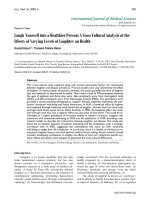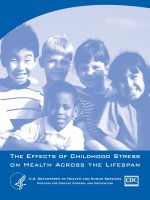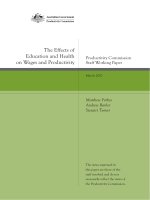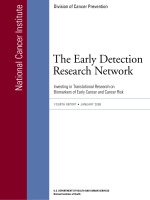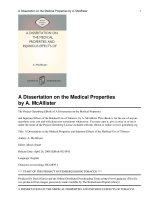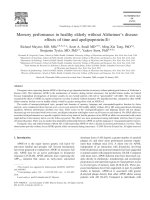Today’s Research on Aging - Effects of Early Life on Elderly Health potx
Bạn đang xem bản rút gọn của tài liệu. Xem và tải ngay bản đầy đủ của tài liệu tại đây (528.91 KB, 5 trang )
Today’s Research on Aging
Personal choices made earlier in life can have lasting effects
on elderly health. Decisions about exercise, nutrition, smok-
ing, and drinking behavior, as well as some less obvious
choices such as pursuit of higher education, whether or not
to marry, and which neighborhood to live in all have conse-
quences much later in life. Not only can such choices in
one’s adult life affect elderly health, but so can characteristics
of one’s childhood.
The Behavioral and Social Research Program at the
National Institute on Aging (NIA) supports analysis of the
effects of early life on elderly health. Knowledge gained from
these analyses can help design programs to improve the
choices people make both for themselves and for their chil-
dren. In this newsletter, we discuss both NIA-sponsored and
other research about the effects of early life on adult and
elderly health.
Mechanisms and Pathways
There are multiple and complex mechanisms and pathways
through which conditions in early life (such as pregnancy,
infancy, childhood, adolescence) may affect one’s health as an
adult. Parental health, especially the mother’s health, plays an
important role in the health of the newborn, and may then
affect adult health (Palloni 2006; Currie and Moretti 2007).
Infections and inflammation in early life may contribute to
explaining adult health (Crimmins and Finch 2006), and
under certain conditions, exposure to poor nutrition and
infectious diseases in early life or before birth or shortly after-
ward may negatively affect adult health (Doblhammer 2003;
McEniry and Palloni, forthcoming; McEniry et al. 2008).
Greater exposure of children to infectious diseases during the
first year of life can lead to higher adult mortality (Bengtsson
and Lindstrom 2003). Poor childhood health and adverse
childhood socioeconomic conditions may also have direct
and indirect negative impacts on adult health (Palloni 2006;
Palloni et al. 2005; Case, Fertig, and Paxson 2005; Elo and
Preston 1992; Luo and Waite 2005).
Not yet clear is the relative importance of these individual
childhood factors in comparison with other factors such as
adult risk behavior (smoking, drinking, exercising, diet) or
adult education and income, which may also affect adult
health (Palloni 2006; Herd, Goesling, and House 2007). In
addition, we need to better understand the impact of larger
societal events such as macroeconomic conditions or social pol-
icies experienced in childhood that may affect childhood risk
factors. For example, during depressions or economic down-
turns, more women and children may suffer from poor living
conditions, resulting in greater malnutrition and exposure to
disease (van den Berg, Lindeboom, and Portrait 2006). Social
policies experienced in some circumstances may also affect
infant health and later adult health (Almond and Chay 2006).
On the other hand, there is also evidence that the long-term
effect of macroeconomic conditions experienced during child-
hood on adult health is inconsequential (Cutler, Deaton, and
Lleras-Muney 2006; Cutler, Miller, and Norton 2007).
Finally, early life conditions manifest themselves differently
across time and space. Thus, for some birth cohorts, date of
birth or geographic location during childhood may be
important in explaining adult health (Bengtsson and
Lindstrom 2003; Catalano and Bruckner 2006; Ross and
Mirowsky 2001) but only because they reflect poor early life
circumstances that expose individuals to a higher risk of
1
In This Issue
• MechanismsandPathways
• ChildhoodHealth
• Adolescence
• DateofBirth
• SocioeconomicStatus
• Location
• Conclusion
This review summarizes research related to the objectives of the National
Institute on Aging, with emphasis on work conducted at the NIA demogra-
phy centers. Our objective is to provide decisionmakers in government,
business, and nongovernmental organizations with up-to-date scientific evi-
dence relevant to policy debates and program design. These newsletters can
be accessed at www.prb.org/TodaysResearch.aspx.
P r o g r a m a n d Po l i c y im Pl icat io ns
Issue16,April2009
PopulationReferenceBureau|Today’s Research on Aging |No.16 |April2009
Effects of Early Life on Elderly Health
2
PopulationReferenceBureau|Today’s Research on Aging
2
PopulationReferenceBureau|Today’s Research on Aging |No.14 |September2008
poor health. As societal conditions improved, the threat of
poor nutrition and infectious diseases experienced during
childhood has declined over time in many countries and
birth cohorts are more likely to live longer (Catalano and
Bruckner 2006). Nutritional status of children has thus
improved because less energy is now expended in supporting
a heightened immune response and more energy may be
devoted to supporting growth and development (Palloni et
al. 2005). For other countries, and indeed within some
countries, however, addressing poor nutrition and infectious
diseases along with poor socioeconomic conditions and poor
childhood health continue to be important challenges that
may very well help explain adult health.
Childhood Health
A large number of events and circumstances in childhood
can affect elderly health. Anything from a traumatic experi-
ence such as the death of a family member, to a more
chronic situation such as exposure to pollution or second-
hand smoke as a child may eventually affect adult health
and well-being. Researchers have mainly examined two
aspects of childhood—early health and socioeconomic sta-
tus—that may influence adult and elderly health.
According to one review of early research, an individual’s
date and place of birth appears to be persistently associated
with risks of adult death in a wide variety of circumstances,
and an individual’s height—an indicator of nutritional and
disease environment in childhood—has also been linked to
adult mortality, especially from cardiovascular diseases (Elo
and Preston 1992). For some diseases such as tuberculosis,
an infection acquired in childhood may not manifest itself
until much later. Other diseases attack an organ system, and
the impairment creates a chronic weakness that can lead to
death later in life. Cirrhosis, liver cancer, rheumatic heart
disease, and respiratory infections and bronchitis are among
diseases in the latter category.
Recent research indicates that, even when controlling for
parents’ incomes, educational attainment, and social status,
adults who experienced poor health as children have signifi-
cantly lower educational attainment, lower earnings, and poor-
er health compared with adults who did not experience poor
health in their childhood (Case, Fertig, and Paxson 2005).
This is somewhat consistent with earlier findings that poorer
children enter adulthood in worse health and with less educa-
tion than wealthier children. These results also lend support to
a suggestion that childhood health, more so than adult eco-
nomic status, is a key determinant of health in adulthood.
Using data from the 1998 Health and Retirement Study
in the United States, researchers found that for six self-
reported measures of physical, mental, and cognitive well-
being, higher childhood socioeconomic status was strongly
associated with better adult health outcomes (Luo and Waite
2005). There is also evidence that parental socioeconomic
status affects child health and that child health relates to
future educational and labor market outcomes (Currie
2009). These educational and labor market outcomes, as
well as other factors affected by childhood socioeconomic
status, can have lasting effects on adult and elderly health
and well-being.
From a psychological or mental health perspective, howev-
er, some childhood experience of disadvantage may help a
person develop a greater ability to cope with stressful events
later in life (Copley and Williams 2006). On the other
hand, recent research finds that mental health problems
identified even once in childhood have an effect on school-
ing. Physical health problems in early childhood predict
young adult health, but only if these health problems persist
for multiple periods do they affect schooling and welfare
participation (Currie et al., forthcoming).
Adolescence
Childhood and adolescent socioeconomic status influences
preferences for smoking, drinking, educational attainment,
and risk taking (Hayward and Gorman 2004). These behav-
iors and choices usually manifest during the adolescent
years. The impact of these behaviors on health is thought to
be additive over the life course and, as a result, affects elder-
ly health (Palloni 2006).
Also, because the adolescent years are a time of drastic
growth and puberty, diet during this time of life can have a
major influence on health later in life. For example, approxi-
mately 40 percent of peak bone mass in girls is accumulated
during their adolescent years (Weaver, Peacock, and
Johnston 1999). While exercise, smoking behavior, and
some other lifestyle choices affect bone acquisition, these do
not compare to the importance of consuming adequate
amounts of calcium. The development of a higher peak
bone mass during the adolescent years protects against bone
loss and osteoporosis in postmenopausal women.
Retrospective studies of postmenopausal women in China
reveal that bone density is positively associated with milk
consumption in adolescent years. Most teenage girls do not
achieve the recommended intake of calcium per day—a cir-
cumstance that may be related to their concern with body
PopulationReferenceBureau|Today’s Research on Aging |No.16 |April2009
smoking, binge drinking, and lack of exercise. These behaviors
have lasting effects on lifelong health.
Other researchers have found that early life education has
a significant impact on cognitive performance in late life
(Cagney and Lauderdale 2002). This effect may occur
because educated people are more likely to be in contact
with other educated people such as co-workers or spouses,
thereby increasing mental stimulation. There is also some
evidence that the association between education and health
has become stronger in recent decades (Lauderdale 2001).
In a study of Californian births, Currie and Moretti
(2007) find that mothers who were low birth-weight babies
were more likely to have low birth-weight babies. This
“transmission” of low birth weight occurred even more often
among mothers in high-poverty zip codes. Low birth weight
in turn was associated with lower socioeconomic status later
in life and again, these effects were stronger for women born
in high-poverty zip codes.
Location
An individual’s education, income, and employment status
have a greater effect on health than does living in a disadvan-
taged neighborhood. Nonetheless, individuals who live in
disadvantaged neighborhoods seem to experience worse
health as a result of the environment in which they live.
Disadvantaged neighborhoods have high percentages of peo-
ple living below poverty line, female-headed households,
people who are not college educated, and low rates of home-
ownership. Living in a disadvantaged neighborhood does not
affect health directly, but the stress, fear, and neighborhood
disorder associated with these characteristics erode health.
Fear and stress increase blood pressure and serum cholester-
ol, and may increase a person’s risk of diabetes, stroke, and
heart disease (Ross and Mirowsky 2001).
In addition to the effects of one’s neighborhood, many
health differences occur at the state and regional level. For
example, there is geographic variation in the rates of hip
fracture for elderly whites in the United States. Furthermore,
where people lived early in their lives explains more about
individual differences in hip fractures than where a person
lived at the time of the actual hip fracture (Lauderdale,
Thisted, and Goldberg 1998), but the relationship between
the region or state of residence in early life and hip fracture
risks in elderly life is unclear. Such factors may be directly
related to geography through the amount of sunlight, weath-
er, and altitude, or indirectly related through variation in the
concentration of poverty, diet, or medical practices.
3
PopulationReferenceBureau|Today’s Research on Aging |No.16 |April2009
image (Weaver, Peacock, and Johnston 1999). In a study of
women who immigrated from Southeast Asia, Diane
Lauderdale and her colleagues (2001) found the following
characteristics of their lives before immigration predicted
high bone mineral density later in life: more years of educa-
tion, earlier age of menarche, lower height, and coastal birth
(a proxy for seafood consumption).
Date of Birth
Evidence shows that as child mortality has fallen over time,
so has adult mortality. Catalano and Bruckner (2006) sug-
gest that as birth cohorts are exposed to fewer or less virulent
infections, injuries, or traumas in childhood, these cohorts
are more likely to live longer.
A comparison of black and white cohorts from the 1960s
also indicates an effect of birth year. Black women born in
the late 1960s have lower risk factor rates as adults and are
much less likely to give birth to an infant with low birth
weight than black women born in the early 1960s (Almond
and Chay 2006). A similar comparison of white women
born in the late 1960s to white women born in the early
1960s showed smaller differences consistent with the small-
er improvement in white infant mortality rates in the 1960s
relative to black infant mortality rates. Almond and Chay
concluded that the social policies that led to the infant
health improvements in the 1960s, such as Title VI of the
1964 Civil Rights Act, had long-run and intergenerational
health benefits.
Socioeconomic Status
A disadvantaged background is often associated with poor
childhood health, and poor childhood health adversely
affects educational attainment and wealth accumulation as
an adult, reproducing socioeconomic disadvantage (Haas
2006; Palloni 2006).
Using data from the Americans’ Changing Lives Study
(1986 through 2001/2002), Herd, Goesling, and House
(2007) tested the effects of education and income on different
stages of health problems and found that education is a stron-
ger predictor than income of whether an individual develops
health problems such as functional limitations or chronic con-
ditions such as diabetes. Many economists believe that the
mechanisms through which more education is correlated with
better health show that more-educated people are better able
to understand and use new health information and thus more
likely to benefit from health care. Also, people with less educa-
tion tend to exhibit more risky health behaviors, including
Conclusion
Numerous studies have found significant relationships
between early life conditions and adult health and the prob-
ability of dying. Multiple, complex pathways and mecha-
nisms may act independently or together to explain these
relationships. Under certain conditions, parental health,
exposure to poor nutrition or infections in early life, being
born to parents in poverty, or experiencing poor childhood
health may adversely affect adult health. Although these
studies provide valuable insight into the impact of early life
circumstances, there is still much not known about the con-
ditions under which early life exposures are later manifested
in poor adult health. In addition, ascertaining the relative
importance of early life circumstances in determining death
and illness as societal conditions change over time and the
impact of macro-level social policies on early childhood
experiences continues to be an important research endeavor.
References
Douglas Almond and Kenneth Chay, “The Long-Run and
Intergenerational Impact of Poor Infant Health: Evidence From
Cohorts Born During the Civil Rights Era,” presentation at the
National Poverty Center, University of Michigan, February 2006,
accessed online at www.npc.umich.edu/news/events/healtheffects_
agenda/chay_npc_paper.pdf, on April 3, 2009.
Tommy Bengtsson and Martin Lindstrom, “Airborne Infectious
Diseases During Infancy and Mortality in Later Life in Southern
Sweden, 1766-1894,” International Journal of Epidemiology 32, no.
2 (2003): 286-94.
Kathleen A. Cagney and Diane S. Lauderdale, “Education, Wealth
and Cognitive Function in Later Life,” The Journals of Gerontology
Series B: Psychological Sciences and Social Sciences 57, no. 2 (2002):
P163-72.
Anne Case, Angela Fertig, and Christina Paxson, “The Lasting
Impact of Childhood Health and Circumstance,” Journal of Health
Economics 24, no. 2 (2005): 365-89.
Ralph Catalano and Tim Bruckner, “Child Mortality and Cohort
Life Span: A Test of Diminished Entelechy,” International Journal
of Epidemiology 35, no. 5 (2006): 1264-69.
Leeda J. Copley and Kristi L. Williams, “The Effects of Childhood
Disadvantage on Later-Life Health and Well-Being,” paper pre-
sented at the annual meeting of the American Sociological
Association, August 2006, accessed online at www.allacademic.
com/meta/p103123_index.html, on July 19, 2008.
4
PopulationReferenceBureau|Today’s Research on Aging |No.16 |April2009
Eileen M. Crimmins and Caleb E. Finch, “Infection,
Inflammation, Height and Longevity,” PNAS 103, no. 2 (2006):
498-503.
Janet Currie and Enrico Moretti, “Biology as Destiny? Short- and
Long-Run Determinants of Intergenerational Transmission of Birth
Weight,” Journal of Labor Economics 25, no. 2 (2007): 231-64.
Janet Currie, “Healthy, Wealthy, and Wise: Socioeconomic Status,
Poor Health in Childhood, and Human Capital Development,”
Journal of Economic Literature 47, no. 1 (2009): 87-122
Janet Currie et al., “Child Health and Young Adult Outcomes,”
Journal of Human Resources (forthcoming).
David Cutler, Angus Deaton, and Adriana Lleras-Muney, “The
Determinants of Mortality,” Journal of Economic Perspectives 20,
no. 3 (2006): 97-120.
David Cutler, Grant Miller, and Douglas Norton, “Evidence on
Early-Life Income and Late-Life Health From America’s Dust Bowl
Era,” Proceedings of the National Academy of Sciences of the United
States of America 104, no. 33 (2007): 13244-49.
Gabriele Doblhammer, “Commentary: Infectious Diseases During
Infancy and Mortality in Later Life,” International Journal of
Epidemiology 32, no. 2 (2003): 294-95.
Irma T. Elo and Sam H. Preston, “Effects of Early Life Conditions
on Adult Mortality: A Review,” Population Index 58, no. 2 (1992):
186-212.
Steve Haas, “Health Selection and the Process of Social
Stratification: The Effect of Childhood Health on Socioeconomic
Attainment,” Journal of Health and Social Behavior 47, no. 4
(2006): 339-54.
Mark Hayward and Bridget K. Gorman, “The Long-Arm of
Childhood: The Influence of Early-Life Social Conditions on
Men’s Mortality,” Demography 41, no. 1 (2004): 87-107.
Pamela Herd, Brian Goesling, and James S. House, “Socioeconomic
Position and Health: The Differential Effects of Education versus
Income on the Onset versus Progression of Health Problems,”
Journal of Health and Social Behavior 48, no. 3 (2007): 223-38.
Diane S. Lauderdale, “Education and Survival in the United States:
Birth Cohort, Period and Age Effects,” Demography 38, no. 4
(2001): 551-61.
Diane S. Lauderdale et al., “Life Course Predictors of Ultrasonic
Heel Measurement in a Cross-Sectional Study of Immigrant
Women From Southeast Asia,” American Journal of Epidemiology
153, no. 6 (2001): 581-86.
PopulationReferenceBureau|Today’s Research on Aging |No.16 |April2009
Diane S. Lauderdale, Ronald A. Thisted, and Jack Goldberg, “Is
Geographic Variation in Hip Fracture Rates Related to Current or
Former Region of Residence?” Epidemiology 9, no. 6 (1998): 574-77.
Ye Luo and Linda J. Waite, “The Impact of Childhood and Adult
SES on Physical, Mental, and Cognitive Well-Being in Later Life,”
The Journals of Gerontology Series B: Psychological Sciences and Social
Sciences 60, no. 2 (2005): S93-101.
Mary McEniry et al., “Early Life Exposure to Poor Nutrition and
Infectious Diseases and its Effects on the Health of Older Puerto
Rican Adults,” The Journals of Gerontology Series B: Psychological
Sciences and Social Sciences 63, no. 6 (2008): S337-48.
Mary McEniry and Alberto Palloni, “Early Life Exposures and the
Occurrence and Timing of Heart Disease Among the Older Adult
Puerto Rican Population,” Demography (forthcoming).
Alberto Palloni, “Reproducing Inequalities: Luck, Wallets, and the
Enduring Effects of Childhood Health,” Demography 43, no. 4
(2006): 587-615.
Alberto Palloni et al., “The Influence of Early Conditions on
Health Status Among Elderly Puerto Ricans,” Social Biology 52,
no. 3-4 (2005): 132-63.
Catherine E. Ross and John Mirowsky, “Neighborhood
Disadvantage, Disorder, and Health,” Journal of Health and Social
Behavior 42, no. 3 (2001): 258-76.
Gerard van den Berg, Maarten Lindeboom, and France Portrait,
“Economic Conditions Early in Life and Individual Mortality,”
American Economic Review 96, no. 1 (2006): 290-302.
Connie M. Weaver, Munro Peacock, and Conrad Johnston Jr.,
“Adolescent Nutrition in the Prevention of Postmenopausal
Osteoporosis,” Journal of Clinical Endocrinology & Metabolism 84,
no. 6 (1999): 1839-43.
The NIA Demography Centers
TheNationalInstituteonAgingsupports13research
centersonthedemographyandeconomicsofaging,
basedattheUniversityofCaliforniaatBerkeley,the
UniversityofChicago,HarvardUniversity,theUniversity
ofMichigan,theNationalBureauofEconomic
Research,theUniversityofNorthCarolina,the
UniversityofPennsylvania,PennsylvaniaState
University,PrincetonUniversity,RANDCorporation,
StanfordUniversity,theUniversityofSouthern
California/UniversityofCaliforniaatLosAngeles,and
theUniversityofWisconsin.
ThisnewsletterwasproducedbythePopulation
ReferenceBureauwithfundingfromtheUniversityof
MichiganDemographyCenter.Thiscentercoordinates
disseminationoffindingsfromthe13NIAdemography
centerslistedabove.ThisissuewaswrittenbyDiana
Lavery,aninternatthePopulationReferenceBureau;
andMarleneLee,aseniorresearchassociateatPRB.
For More Information
Late Life Legacy of Very Early Life,GabrieleDoblhammer
www.demogr.mpg.de/books/drm/002/index.htm
Journal of Social Biology52,no.3-4(2005)
www.soc.duke.edu/~socbio/socbio_2003through2006.htm
Military Service and Health Outcomes in Later Life
www-cpr.maxwell.syr.edu/research/military_service.htm
5
1875 Connecticut Ave., NW 202-483-1100
PHONE
Suite 520 202-328-3937
FAX
Washington, DC 20009-5728 www.prb.org
WEB
USA
POPULATION REFERENCE BUREAU
